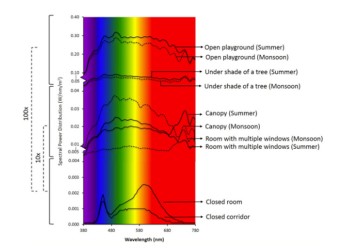A prospective study by Rohit Dhakal and Dr Pavan Verkicharla from L V Prasad Eye Institute investigates the variation in spectral distribution of ambient light to understand its role in myopia genesis. The study identifies the differences in the spectral power in various indoor and outdoor settings and across time.
Exposure to sunlight as indirectly determined by time spent outdoors is believed to be important for ocular development and myopia onset. Several studies have found that daily sunlight exposure reduces the incidence of juvenile myopia. There is a lot of research in trying to understand the specific actions that sunlight has on the development of the eyeball and in prevention of myopia. Leading theories range from sunlight-induced dopamine release in the retina to luminance-induced pupil constriction. Some researchers are trying to break down the effect within the optical spectrum, to see if specific wavelengths bestow specific, protective benefits for prevention and control of myopia.
There is some evidence to show that specific wavelengths of light may influence eyeball elongation. Illuminance, the amount of light in a particular space, also impacts myopia and the variation in light exposure across the seasons may play a role too. Therefore, there is value in investigating the variation in the spectral composition of ambient light at different times of the day, and in different seasons. Such an understanding will lay a foundation for future research to understand the relationship between spectral power and the development of myopia, and thereby help tweak light exposure guidance to parents, based on time of day, location, and season.
A new paper in the Ophthalmic and Physiological Optics investigates just such a variation in the distribution of spectral composition of light in Hyderabad. The study recorded ambient light in different indoor and outdoor locations, at different times of the day, across two seasons (Summer and the Monsoon). Using a handheld spectrometer, the authors recorded different parameters of ambient light, including its spectral composition, dominant wavelength and ‘spectral power distribution’ (SPD, the light source’s strength per unit area and unit wavelength).
The study found significant variation in SPD across locations, time periods in the day, and the summer and monsoon seasons. The spectral power distribution in all outdoor locations was 154 times higher than indoor locations overall. SPD also showed diurnal variation, with higher SPD in the mornings and lower in the evenings (except indoors, which benefited from LED lights). The study notes variation in the spectrum of light wavelengths (short, medium and long) across seasons. This variation was noted during the day and evening time and in all the locations (except under the canopy of large trees). The authors emphasize that exploring these SPD values may help in understanding the protective mechanism of outdoor light exposure for myopia.
‘This research is the starting point in our search for understanding the role of the spectral composition of ambient light in myopia. It seems likely in the near future that we may have more light-based treatment options for managing myopia,’ says Pavan Verkicharla, the corresponding author of this paper and Head, Infor Myopia Centre at LVPEI.
Citation
Dhakal, R, Huntjens, B, Shah, R, Lawrenson, JG, Verkicharla, PK. Influence of location, season and time of day on the spectral composition of ambient light: Investigation for application in myopia. Ophthalmic Physiol Opt. 2023; 43: 220– 230. https://doi.org/10.1111/opo.13085
Photo credit: Figure 4, Pattern of spectral power distribution curves for different locations, Dhakal et al.



